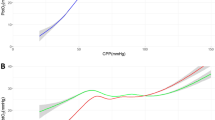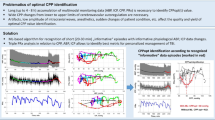Abstract
Background
Although abnormally high Lactate/Pyruvate ratio (LPR) could indicate cerebral ischemia for brain injury patients, there is a debate on what is primary factor responsible for LPR increase.
Methods
A data analysis experiment is taken to test whether any association between cerebral vasodilatation/vasoconstriction and LPR increase exists. We studied 4,316 microdialysis data samples collected in an average interval of 1.3 h from 30 severe traumatic brain injury (TBI) patients. The LPR increase episodes were automatically identified using a moving time-window of 5 samples. A novel pulse morphological template matching (PMTM) algorithm was applied to the intracranial pressure (ICP) data of the corresponding patients to assess the occurrence of cerebral vasodilatation and vasoconstriction during the identified LPR increase episodes. Several analyses were performed to evaluate the association between cerebral vasoconstriction/vasodilatation and LPR increase.
Results
Results revealed that although more than half of the LPR increase episodes are not associated with any detected cerebral vasoconstriction/vasodilatation, when a vaso–change happens in association of LPR increase, it is more likely that this vaso–change is in the form of vasoconstriction rather than vasodilatation. Also for few subjects with dominant number of vasoconstriction episodes, a causality relationship between vasoconstriction and LPR increase were observed (vasoconstriction precedes LPR increase).
Conclusions
Using continuous intracranial pressure monitoring and our pulse morphological template matching (PMTM) algorithm could be potentially helpful in teasing out whether culprit cerebral vascular changes precede metabolic crisis for traumatic brain injury patients and hence guiding the management of this condition.




Similar content being viewed by others
References
Meyerson BA, Linderoth B, Karlsson H, Ungerstedt U. Microdialysis in the human brain: extracellular measurements in the thalamus of parkinsonian patients. Life Sci. 1990;46:301–8.
Ungerstedt U, Rostami E. Microdialysis in neurointensive care. Curr Pharm Des. 2004;10:2145–52.
Hillered L, Vespa PM, Hovda DA. Translational neurochemical research in acute human brain injury: the current status and potential future for cerebral microdialysis. J Neurotrauma. 2005;22:3–41.
Tisdall MM, Smith M. Cerebral microdialysis: research technique or clinical tool. Br J Anaesth. 2006;97:18–25.
Choi IY, Lee SP, Kim SG, Gruetter R. In vivo measurements of brain glucose transport using the reversible Michaelis-Menten model and simultaneous measurements of cerebral blood flow changes during hypoglycemia. J Cereb Blood Flow Metab. 2001;21:653–63.
Vespa P, Bergsneider M, Hattori N, et al. Metabolic crisis without brain ischemia is common after traumatic brain injury: a combined microdialysis and positron emission tomography study. J Cereb Blood Flow Metab. 2005;25:763–74.
Laitinen L. Origin of arterial pulsation of cerebrospinal fluid. Acta Neurol Scand. 1968;44:168–76.
Czosnyka M, Guazzo E, Whitehouse M, et al. Significance of intracranial pressure waveform analysis after head injury. Acta Neurochir (Wien). 1996;138:531–41. discussion 41-2.
Cardoso ER, Rowan JO, Galbraith S. Analysis of the cerebrospinal fluid pulse wave in intracranial pressure. J Neurosurg. 1983;59:817–21.
Hu X, Xu P, Scalzo F, Vespa P, Bergsneider M. Morphological clustering and analysis of continuous intracranial pressure. IEEE Trans Biomed Eng. 2009;56:696–705.
Hu X, Glenn T, Scalzo F, et al. Intracranial pressure pulse morphological features improved detection of decreased cerebral blood flow. Physiol Meas. 2010;31:679–95.
Asgari S, Bergsneider M, Hamilton R, Vespa P, Hu X. Consistent changes in intracranial pressure waveform morphology induced by acute hypercapnic cerebral vasodilatation. Neurocrit Care. 2011;15:55–62.
Asgari S, Vespa P, Bergsneider M, Hu X. Lack of consistent intracranial pressure pulse morphological changes during episodes of microdialysis lactate/pyruvate ratio increase. Physiol Meas. 2011;32:1639–51.
Asgari S, Gonzalez N, Subudhi AW, et al. Continuous detection of cerebral vasodilatation and vasoconstriction using intracranial pulse morphological template matching. Plos one. 2012;7:e50795.
Ronne-Engstrom E, Hillered L, Flink R, Spannare B, Ungerstedt U, Carlson H. Intracerebral microdialysis of extracellular amino acids in the human epileptic focus. J Cereb Blood Flow Metab. 1992;12:873–6.
Enblad P, Valtysson J, Andersson J, et al. Simultaneous intracerebral microdialysis and positron emission tomography in the detection of ischemia in patients with subarachnoid hemorrhage. J Cereb Blood Flow Metab. 1996;16:637–44.
Hutchinson PJ, Gupta AK, Fryer TF, et al. Correlation between cerebral blood flow, substrate delivery, and metabolism in head injury: a combined microdialysis and triple oxygen positron emission tomography study. J Cereb Blood Flow Metab. 2002;22:735–45.
Maurer MH, Haux D, Sakowitz OW, Unterberg AW, Kuschinsky W. Identification of early markers for symptomatic vasospasm in human cerebral microdialysate after subarachnoid hemorrhage: preliminary results of a proteome-wide screening. J Cereb Blood Flow Metab. 2007;27:1675–83.
Helmy A, Carpenter KL, Menon DK, Pickard JD, Hutchinson PJ. The cytokine response to human traumatic brain injury: temporal profiles and evidence for cerebral parenchymal production. J Cereb Blood Flow Metab. 2011;31:658–70.
Persson L, Hillered L. Chemical monitoring of neurosurgical intensive care patients using intracerebral microdialysis. J Neurosurg. 1992;76:72–80.
Enblad P, Frykholm P, Valtysson J, et al. Middle cerebral artery occlusion and reperfusion in primates monitored by microdialysis and sequential positron emission tomography. Stroke. 2001;32:1574–80.
Clausen T, Zauner A, Levasseur JE, Rice AC, Bullock R. Induced mitochondrial failure in the feline brain: implications for understanding acute post-traumatic metabolic events. Brain Res. 2001;908:35–48.
Nelson DW, Bellander BM, Maccallum RM, et al. Cerebral microdialysis of patients with severe traumatic brain injury exhibits highly individualistic patterns as visualized by cluster analysis with self-organizing maps. Crit Care Med. 2004;32:2428–36.
Bjerring PN, Hauerberg J, Jorgensen L, et al. Brain hypoxanthine concentration correlates to lactate/pyruvate ratio but not intracranial pressure in patients with acute liver failure. J Hepatol. 2010;53:1054–8.
Vespa PM, O’Phelan K, McArthur D, et al. Pericontusional brain tissue exhibits persistent elevation of lactate/pyruvate ratio independent of cerebral perfusion pressure. Crit Care Med. 2007;35:1153–60.
Westermaier T, Jauss A, Eriskat J, Kunze E, Roosen K. The temporal profile of cerebral blood flow and tissue metabolites indicates sustained metabolic depression after experimental subarachnoid hemorrhage in rats. Neurosurgery. 2011;68:223–9. discussion 9-30.
Marion DW, Puccio A, Wisniewski SR, et al. Effect of hyperventilation on extracellular concentrations of glutamate, lactate, pyruvate, and local cerebral blood flow in patients with severe traumatic brain injury. Crit Care Med. 2002;30:2619–25.
Acknowledgments
The present work is partially supported by NS066008, NS076738, and UC Brain Injury Research Center (BIRC).
Author information
Authors and Affiliations
Corresponding author
Rights and permissions
About this article
Cite this article
Asgari, S., Vespa, P. & Hu, X. Is There Any Association Between Cerebral Vasoconstriction/Vasodilatation and Microdialysis Lactate to Pyruvate Ratio Increase?. Neurocrit Care 19, 56–64 (2013). https://doi.org/10.1007/s12028-013-9821-6
Published:
Issue Date:
DOI: https://doi.org/10.1007/s12028-013-9821-6




